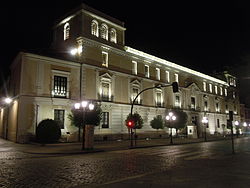Royal Palace of Valladolid
- View a machine-translated version of the Spanish article.
- Machine translation, like DeepL or Google Translate, is a useful starting point for translations, but translators must revise errors as necessary and confirm that the translation is accurate, rather than simply copy-pasting machine-translated text into the English Wikipedia.
- Consider adding a topic to this template: there are already 5,025 articles in the main category, and specifying
|topic=will aid in categorization. - Do not translate text that appears unreliable or low-quality. If possible, verify the text with references provided in the foreign-language article.
- You must provide copyright attribution in the edit summary accompanying your translation by providing an interlanguage link to the source of your translation. A model attribution edit summary is
Content in this edit is translated from the existing Spanish Wikipedia article at [[:es:Palacio Real de Valladolid]]; see its history for attribution. - You may also add the template
{{Translated|es|Palacio Real de Valladolid}}to the talk page. - For more guidance, see Wikipedia:Translation.
| Royal Palace of Valladolid | |
|---|---|
Palacio Real de Valladolid | |
 Royal Palace of Valladolid | |
 | |
| General information | |
| Architectural style | Renaissance |
| Town or city |  Valladolid, Valladolid,  Castile and León, Castile and León,  Spain Spain |
| Construction started | Early 16th century |
| Client | Charles V, Holy Roman Emperor Philip II of Spain Philip III of Spain Napoleon |
| Official name | Palacio Real de Valladolid |
| Criteria | Monument |
| Designated | 06-18-1999 |
| Reference no. | RI-51-0010470 |
The Royal Palace of Valladolid was the official residence of the kings of Spain during the period in which the royal court had its seat in Valladolid between 1601 and 1606, and a temporary residence of the Spanish monarchs from Charles I to Isabella II, as well as of Napoleon during the Peninsular War. Currently it is the headquarters of the 4th General Sub-inspection of the Spanish Army.



History
Despite the fact that kings were present in Valladolid often, they lacked an official residence until the 17th century. When the Royal Court moved to the city, the palace of Francisco de los Cobos y Molina fulfilled that function. Francisco de los Cobos was a Secretary of State under Charles V, Holy Roman Emperor (King Charles I of Spain). Born in Úbeda, de los Cobos forged a spectacular political career. He married in 1522 María de Mendoza, daughter of the Count of Ribadavia, achieving thus the nobility rank that he lacked. De los Cobos built his palace nearby his in-laws (Palace of the Counts of Ribadavia) and next to St. Paul's Church, according to a 1524 project of royal architect Luis de Vega. The building was built around a magnificent, Renaissance-styled courtyard. Charles V later ordered its extension, resulting in a building of complicated compositions: several courtyards, chapel, state rooms...
Use
In the 19th century the palace was transferred to the Spanish army and became the headquarters of the General Captaincy of the 7th Military Region (currently the 4th General Sub-inspection) of the Army. At the beginning of the 20th century significant renovations were made, with numerous structural changes being made to its original design.
References
External links
- Information on the Valladolid Tourist Board website (Spanish)
- v
- t
- e
Patrimonio Nacional
| Royal Palaces | |
|---|---|
| Monasteries | |
| Other |
|

Royal Palaces1
- Alcázar of Segovia
- Alcázar of the Caliphs of Córdoba
- Alcázar of the Catholic Monarchs
- Alhambra
- Aljafería
- Buen Retiro Palace
- Castle Alcázar of Segorbe
- Castle of Bellver
- Castle of Burgos
- Del Real Palace
- Generalife
- Madinat al-Zahra
- Miramar Palace
- Monastery of Yuste
- Palace of Charles V
- Palacio de la Magdalena
- El Quexigal
- Palacio de la Ribera
- Royal Palace of Estella
- Royal Palace of Olite
- Royal Palace of Perpignan
- Royal Palace of Pedralbes
- Palau Reial Major
- Palacio Real de Valladolid
- Royal Alcázar of Madrid
- Torre de la Parada
- Valldemossa Charterhouse
Sub-national seats
- Castel Nuovo
- Royal Palace of Naples
- Palazzo dei Normanni
- Palazzo Regio
- Edificio de las Casas reales
- Palacio del Virrey (present-day the National Palace)
- Palacio de los Capitanes Generales de Cuba
- Palacio de los Capitanes Generales de Guatemala
- Palacio de Pizarro
- Palacio del Fuerte de Buenos Aires
- Palacio Real de Quito
- Palacio Virreinal de Santa Fé de Bogotá
- Palacio del Gobernador de Agaña
- Palacio del Gobernador de las Filipinas
- Palacio de los Gobernadores de Nuevo México
- Royal Palace of Brussels
 Category
Category41°39′23″N 4°43′33″W / 41.6564°N 4.7258°W / 41.6564; -4.7258
 | This article about a palace in Spain is a stub. You can help Wikipedia by expanding it. |
- v
- t
- e











